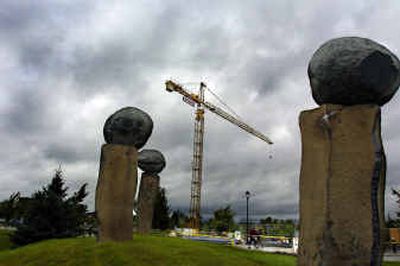WSU cheers centerpiece of new district

What was once a wasteland of railroad yards and old warehouses is fast becoming Spokane’s hope for a strong economic future.
At an early morning celebration Wednesday, Washington State University President V. Lane Rawlins opened the door wider to plans for a University District on the east end of downtown Spokane. At the 53-acre site along the Spokane River where WSU and the Spokane Intercollegiate Research and Technology Institute already have buildings, construction crews are breaking ground on a new Academic Center.
The hulking $33.8 million five-story structure will house classrooms and a library and is slated to be completed in 2006. It will be the heart of campus, and the campus will be the heart of the University District, said Rawlins to the crowd of about 200. The next step, which goes before the state Legislature this year, is a $34.6 million nursing center, furthering WSU’s plans to create a health/science core in Spokane.
For years, Spokane was missing the presence of a research university, said Jon Eliassen, CEO of the Spokane Economic Development Council. Without it, the community has missed out on opportunities to grow in technology and science-based business, he said. But now WSU, with the cooperation of the area’s other schools, has stepped in to fill the void.
Businesses have historically located near raw materials. Today those basic materials aren’t timber or water, they’re knowledge and research, said Eliassen. With scientists, professors and students here at the Spokane campus, businesses and jobs will grow up all around, he said.
When they look at the University District, the city’s leaders are seeing much more than a couple of buildings and a big hole in the ground. They’re seeing a spread of brick and glass, businesses with high-paying jobs sprouting up around the edges, and thousands of college students wandering through.
Since January, WSU has announced plans to co-locate portions of its physics and sleep research programs in Pullman and Spokane. The school was also involved in recruiting genetics researchers Bassem Bejjani and Lisa Shaffer to Spokane to work with WSU scientists and doctors at Sacred Heart Medical Center. In the past year, programs at WSU Spokane have attracted more than $17 million in research funding, and more is coming, said university officials.
Sounds of a backhoe at work on the Academic Center site slipped through the open doors at the Wednesday event where university and city leaders presented the project to the community.
The University District idea has caught the interest and imagination of legislators on both sides of the aisle in Olympia, said State Sen. Lisa Brown, D-Spokane. State leaders will support WSU and the University District idea as it moves to meet the needs of students and the local economy, she said. “We’re excited about the vision.”
While it was clear that WSU is the key educational player in the University District project, the school is making efforts to include Spokane’s community colleges and Eastern Washington University in the next steps. Last year, while WSU was plowing ahead with its plans, local education leaders voiced concern that they were being passed by and impacted by the efforts.
But that is changing now, they said. Early in his talk, Rawlins brought up the formal agreement forged between WSU and Eastern last spring, which would put WSU in charge of the campus, but provide for Eastern to offer programs there. Sometimes you just have to sit down and talk things through, Rawlins told the crowd, “then a lot of things that were confusing suddenly become clear.”
Soaking it in from the audience, Gonzaga University’s president, the Rev. Robert Spitzer, said he’s glad to see the positive changes across the river from his campus. Gonzaga’s leaders are intrigued by the University District concept, but they hope the programs offered there don’t duplicate those already provided at GU. “Obviously we want to participate,” he said.
Others in the community said they hope to be a part of it, too.
“It is so obvious, if you just look around, where we’re headed,” said Rich Hadley, president of the Spokane Regional Chamber of Commerce. “It’s an awesome future.”